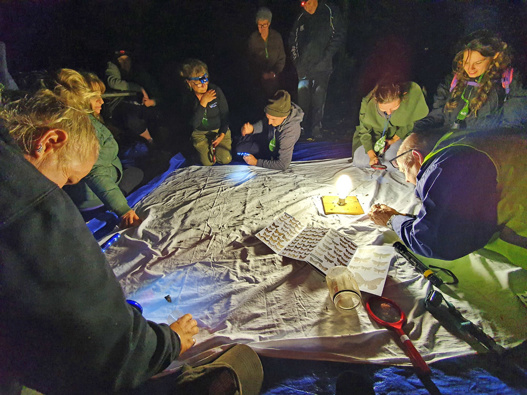It is reasonable well-known among New Zealand Gardeners that insects tend to be attracted to lights; especially lights that are rather blue-ish white in colour. The reason is very simple: these lights contain a rather decent dose of Ultra Violet (UV) light;
Insects can see UV better than any other frequency. I have a UV torch at home that allows me to go out walking in the garden and it shows me – more or less – what moths see when they fly through the garden.
Some folk use this trick to catch the Guava moths that are on their way to lay eggs inside the new very small guava fruit and feijoa fruit that are being formed in summer; a light coupled with a container with diluted dishwashing liquid is the way to kill those buggers before they start the puncturing and subsequent entering of the tiny fruits… “Get the buggers, before they get our fruit”
I have always objected to this idiotic way of “pest control”, simply because there are far better options to stop the guava moths laying eggs on the developing guava and feijoa fruits: Cover the branches with a fine muslin cloth that stops the moths from coming near the fruit’s skin.
Those insect-excluding cloths are available in most garden shops. If you must use some pesticides, then Neem Oil or Success are chemicals that can prevent about 50% of the damage occurring too!
Light trap “pest control” is really very ineffective as you simply catch a heap of moth (and other) insect species that have nothing to do with fruit of crop damage; most of them are native and have an interesting job to do in the ecosystem.
These beetles (Heteronychus and Odontria) are good at pruning shrubs and trees and grasses, but in turn are excellent food for birds, geckoes, skinks, Centipedes and Owls
The absolutely imposing huhu beetle emerges from a log of rotting wood where it has been instrumental in the decomposition of that wood and turning it into nutrients for the next generation of our forest. The beetle is devoured by Morepork; of course, the huhu grub is also edible and full of protein; ask the kaka!
When I take Teachers out at night with a mercury vapour light-trap (full of UV light) we not just look at beetles, but also at a huge range of moths and other flying insects.
Some are just beautiful, like the Lichen moth (Izatha) and the native Scoparia moth, belonging to a very special and numerous group of moths in Aotearoa. All food for insectivorous organisms in your garden; without these native species our birds would go hungry!
But one of my absolute favourite moths is this one: Chrysodeixis eriosoma. The architecture of that Noctuid is outrageous and the silver dots on the wings just elegant.
And no… I’m not going to describe the larval activities of that species – I’m sure you know it!
Take your Radio, Podcasts and Music with you










